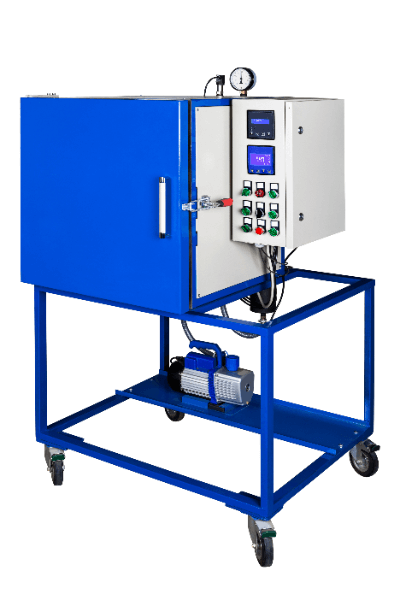What Is a Vacuum Furnace?
 A vacuum furnace is a furnace capable of vacuum heat treatment processing.
A vacuum furnace is a furnace capable of vacuum heat treatment processing.
Since the object is heated in a vacuum furnace, the surface of the object can be processed without oxidizing it. Decarburization is prevented and the luster of stainless steel and other materials can be maintained after heat treatment.
Also, because of the high surface cleanliness, bonding of dissimilar metals can be processed cleanly. A major feature of this process is that distortion can be reduced because of the gradual cooling process from heating to cooling.
This processing method emits less carbon dioxide and reduces variation in dimensions and hardness. In some cases, heat treatment is performed in a Vacuum Furnace with nitrogen gas flowing through it.
Uses of Vacuum Furnace
Vacuum furnaces are mainly used for processing metals and semiconductors.
The following are examples of vacuum furnace applications:
- Quenching, tempering, and sintering of metals
- Brazing of evaporators, etc.
- Annealing
The following are also examples of products manufactured in vacuum furnaces:
- High-grade steels for carbide tools
- Materials for electronic products such as magnets and capacitors
- Automotive parts and industrial machinery parts
Metals that require special features are fabricated in vacuum furnaces. Metals treated in vacuum furnaces are characterized by high luminosity, and surface oxidation and impurities can be reduced.
Vacuum furnaces have many advantages, but they also have the disadvantage of high maintenance and initial installation costs.
Principle of Vacuum Furnaces
Vacuum furnaces use a combination of oil rotary pumps and turbo molecular pumps to exhaust the air inside the furnace and maintain a high vacuum. Heating in the absence of oxygen in a high vacuum prevents oxidation.
1. Vessel Material
Stainless steel is generally used as the furnace vessel material; it can be heated to 1,000°C to 2,300°C and is heated by metal heaters such as tungsten, molybdenum, and silicon carbide.
Smaller furnaces are also available in which the object is heated in a tubular furnace made of alumina or quartz glass. Kanthal wire is used as the heater material, and the furnace can heat up to 700°C to 1,600°C.
2. Cooling Method
Cooling methods include natural cooling, gas cooling, and oil cooling. For high temperatures, the vessel is double-layered and water-cooled. High temperatures are measured externally with a radiation thermometer.
In a standard vacuum furnace, heating and cooling are performed in the same chamber.
Structure of Vacuum Furnaces
Vacuum furnaces perform heat treatment of heat-treated products through the three processes of conveyance, heating, and cooling. There are two main types of furnaces, the “one-chamber type” and the “multi-chamber type,” depending on the type and purpose of the heat-treated parts.
1. One-Chamber Vacuum Furnace
In the one-chamber type vacuum furnace, the operator transfers and places the product to be treated in the furnace, and the heating and cooling processes are performed in a single chamber. Since the heating and cooling processes are performed in the same room, the furnace must be able to withstand sudden temperature differences. Heat-resistant stainless steel or carbon materials are used for the heater and structural components.
Because of its simple structure, the lineup of furnaces is extensive, ranging from small to large sizes. For cooling, natural cooling or inert gas cooling with nitrogen or other inert gases is used to prevent contamination of the furnace interior and heat-treated products. The cooling gas outlet structure and stirring fan enable uniform cooling with minimal contamination.
Therefore, it is suitable for processing products that are sensitive to surface contamination or deformation. On the other hand, the disadvantage is low productivity because the next product to be heat-treated cannot be loaded until the previous treatment is completed.
2. Multi-Chamber Vacuum Furnace
The multi-chamber type vacuum furnace has a structure in which the conveying, heating, and cooling processes are performed in two or more chambers. Heating and cooling are basically completed automatically, as per the settings once the product is fed into the transfer chamber. It is possible to control the temperature in each zone, or to set up multiple heating chambers for small batches and stagger the processing time.
The above innovations can improve productivity. By making cooling in a separate chamber, liquid refrigerants with high cooling capacity, such as oil, can be selected. High cooling capacity can be maintained because the cooling chamber is not heated.
Even metallic materials with low hardenability and sensitive to cooling rates can be cooled to a high level of performance. On the other hand, cleaning is required after heat treatment due to contamination of the treated material by the refrigerant. There is also a risk of distortion and cracking due to the high cooling rate.
Other Information on Vacuum Furnaces
Carbon Components of Vacuum Furnaces
Carbon components such as carbon graphite and C/C composite are used in Vacuum Furnaces. They are used for heating elements, structural materials, and heat treatment jigs.
Carbon materials have high heat resistance, up to 3,000°C. They are lightweight and have a low coefficient of thermal expansion. They are characterized by their light weight, low coefficient of thermal expansion, low deformation due to thermal fatigue, and low heat capacity.
Its light weight allows for increased loading capacity of heat-treated products and reduced setup load. The low deformation resistance also leads to lower running costs. The low thermal capacity and high energy-saving effect provide many productivity-enhancing benefits.
However, a disadvantage is that carbon volatilization during heating causes contamination of the furnace interior and heat-treated parts. The cooling method is also limited to gas cooling only.